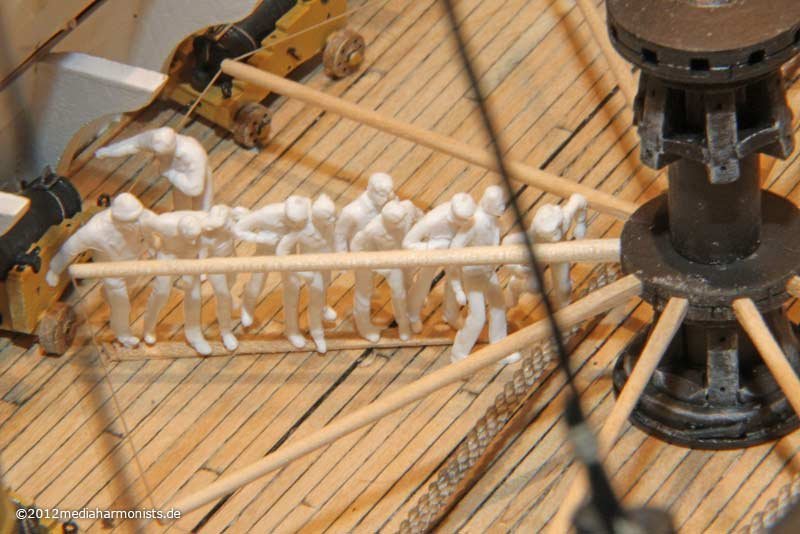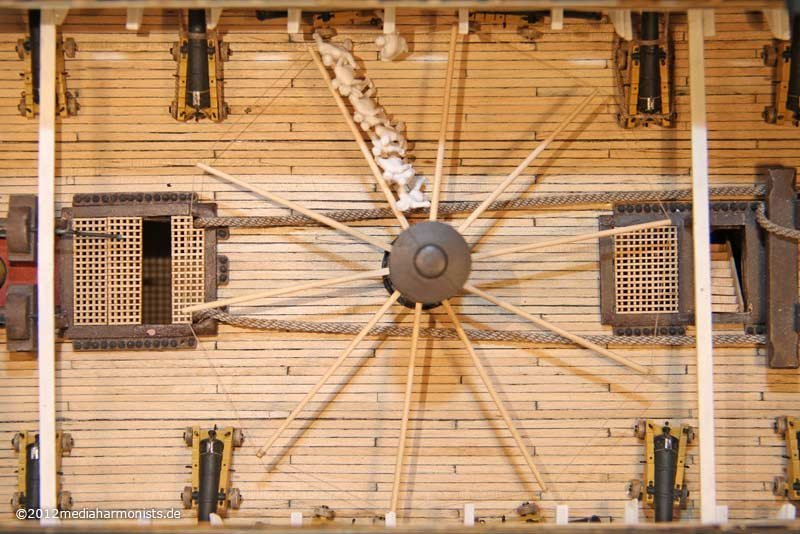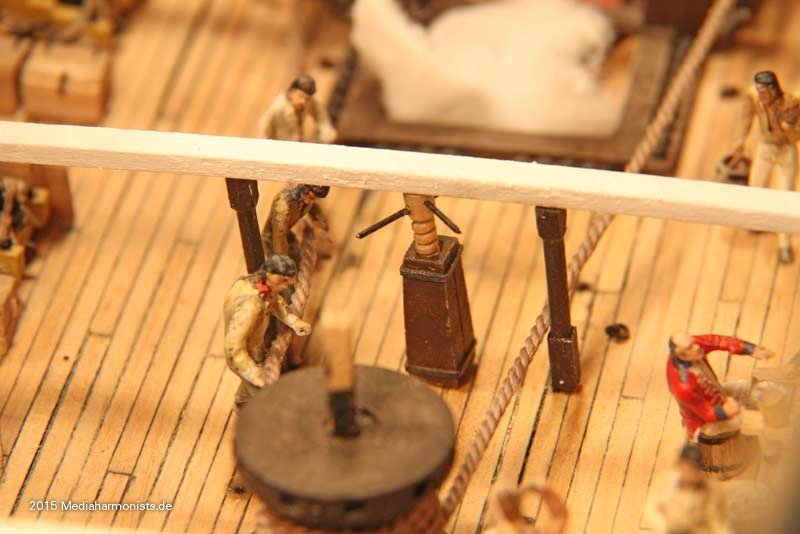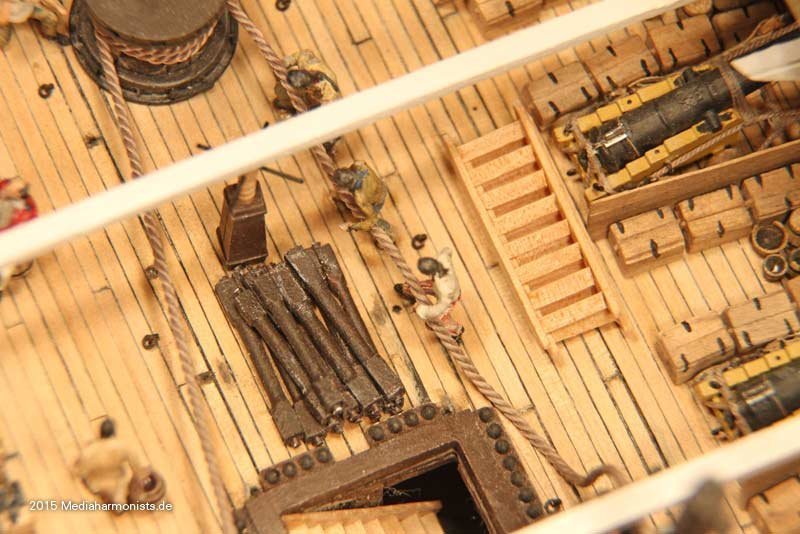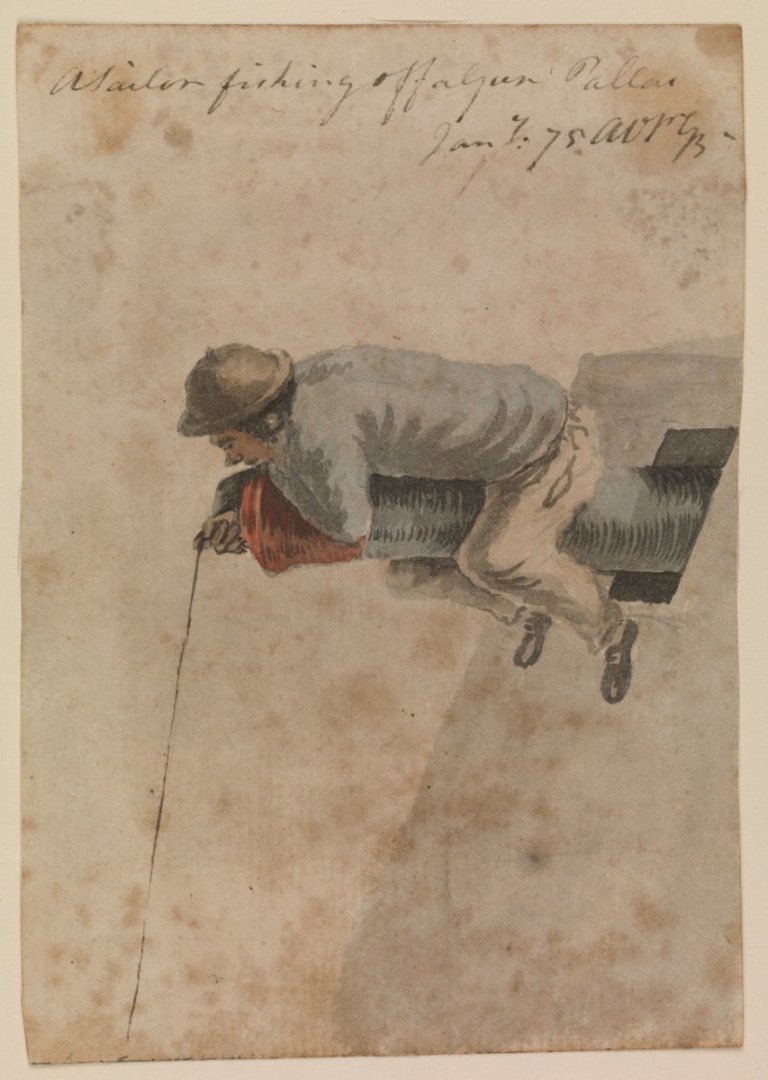-
Posts
2,419 -
Joined
-
Last visited
Content Type
Profiles
Forums
Gallery
Events
Everything posted by dafi
-
In the meantime, Lieutenant John Pasco and his assistant have also arrived at their workplace on the poop deck. The canvas curtains in front of the flag lockers have been drawn back ... ... but oh horror, they are all empty! So quickly placed a bulk order of the current signal flags, 64 pieces, carved from 1.5 x 1.5 mm plastic strip, about 2 mm long, in the colors of the 1803 signal flags. Then covered the hull so no one would get hit by falling flags in the gunroom ... ... and generously assisted him in filling it. One more brief inspection of the result ... ... the flags at the top of the locker secured with weight bags to prevent them from flying away ... ... and he can prepare his flags well ... ... for, after all, it will be him who will translate Nelson's pre-battle greetings to his fleet into usable signals: "England expects that every man will do his duty." XXXDAn
-
dafi Post subject: Re: To HMS Victory and beyond http://www.shipmodels.info/mws_forum/styles/subsilver2/imageset/icon_post_target.gifPosted: Mon Aug 14, 2023 3:21 am http://www.shipmodels.info/mws_forum/styles/subsilver2/imageset/en/icon_user_online.gif http://www.shipmodels.info/mws_forum/images/avatars/gallery/MW-custom/shipyard%20worker.gif Joined: Mon Mar 12, 2012 11:13 am Posts: 865 Location: Ludwigsburg/Germany It went meanwhile to the hammock tinkering. I rolled the hammocks as already seen of my cut versions with spacers out of Fimo into the right diameter and rolled in the structure with a rake, folded and baked them. A little color ... ... and shading ... and whoopee into the hammock cranes ... ... and ready it is. From the quarterdeck it looks like this. Maybe I'll send the guys to wash the hammocks some more, the washing is a bit heavy, but how clean were the mats actually back then, so before the days of washing machines and chlorine bleach? XXXDAn
-
Nowadays at the Vic in P., the rudder pendant goes up to the mizzen chains and is secured there with a toggle. There is an interesting detail on the contemporary model SLR0512 of the Victory: The rudder pendant goes up through the channel board to the poop deck, is routed aft at deck level, and is tied to a cleat further aft. This way, in an emergency, the line is quickly ready for use and does not have to be extended as it is today. A detail I wanted to install for a long time, now it was finally done 🙂 XXXDAn
-
And it was time for the next deck. A long time ago I had already prepared a poop deck. Even then I had reported the phenomenon that the decks slowly warped over months, always concave in relation to the wood, virtually hogging at deck level. Theoretically this is certainly appearing, but it was too much of a problem. This has happened to me three times now. Each time the original Heller part with superglue and 0.4 mm planks. And the thick plastic decks can only be straightened with extreme force. When trying to help with heat, the bending radius shifted to the middle of the plastic, which then led to bulges in the wood. Conclusion: (original) plastic decks that have been covered this way must be glued in immediately and really well, possibly secured on top in a different way. The other method is to mount the new parquet on a carrier medium and glue it down. I have often used paper or cardboard for this purpose, which can also be critical, as this carrier material has already split in its core, i.e. half adhered well to the subfloor and the other half well to the planks, just with a little distance to the original fixing point ... It wasn't so tragic after all, as this deck would have covered too much of the inside views anyway. So I built a new deck cut-out. A long time ago I had also made the railing of the cabin deck to look like Turner's drawings. Now it can finally be installed 🙂 Here are a few test hammocks, the real hammocks are still to come, the ones folded in the middle should fit in. And then the rear end, everything was already there 🙂 The stern can be removed via magnets for a better view. Something done again! XXXDAn
-
Thank you Sirs, very appreciated! It's been a long time, in 2016 I had already discovered the axionometer on the 1765 model of the Victory with the help of my forum colleagues. Since the display can be discovered on Turner's afterdeck view and can also be seen on other contemporary models, I had already installed the display on two of my models back then. Now that Nelson has arrived on his Victory, it was time for me to take care of it again. If you look at the contemporary models with axionometer, only a version with a rope transmission comes into question. In the front area of the rudder wheels, there is no additional drum visible on English ships, so I put it in the back. The rope transmission is analogous to French systems, from which the system was originally copied. I have calculated the diameter of the drum and it kindly agrees with the French systems. For simplicity, I took a virgin steering wheel for pre-assembly. The display with its markings was also quickly built. For the rope guidance I misused the wheel holder of my carronades. So that the sheave also has air for the rope, I made a spacer from 0.3 mm wire. Some paint on it and the rollers were finished Then as usual put my cotton pad underneath so dirt and parts don't disappear into the depths. But I should have packed the whole room in absorbent cotton, because one of those dark 1 cubic millimeter pieces jumped away, of course, because I took the wrong tweezers with flexible jaws. With a flashlight held flat, I was actually able to quickly retrieve the part. All the well-meaning gods involved were praised and lauded! The ends still properly trimmed and everything is ready http://www.shipmodels.info/mws_forum/images/smilies/icon_smile.gif XXXDAn
-
Brief review: 21 November 1805: Nelson falls in an encounter with the French, famously off Trafalgar 21 November 2018: Nelson falls again at an encounter with the French, this time at Rochefort, falling into the hands of an unknown man who pressed him to an unknown destination. Here is the last picture just before the loss. But first things first. This was the last stand of the too small steering wheel planking http://www.shipmodels.info/mws_forum/images/smilies/icon_wink.gif In the meantime, a larger piece of planking had already been built. Also more deck beams were already in place. But the beam to which the steering tackle is attached was pressed down a bit by the planks and the tackle became slack as a result. So once again entering deep into the guts ... ... and fixed the tackle so that I could be tightend after gluing the planking into place. I even shortened a brush to be able to put the paint in the right place http://www.shipmodels.info/mws_forum/images/smilies/icon_smile.gif The stub is there as the tackle doesn't run parallel due to the rudder drum. And now it's time to be strong. It was the turn of Nelson and Hardy's new build. Nelson is a cross-dresser, as you can see. Surgically altered a bit, as they say. The other guys have also arrived, the lieutenant with his speaking trumpet and the two helmsmen, dressed a little more formally than the rest of the crew. As we have very calm seas right now there are only 2 present. And then they were already allowed onto their playfield. And this time he came to stay, brave little Horatio! XXXDAn
-
As for the bars: Goodwin´s Construction and Fitting tells: "one third of the vessel´s extreme beam" I think that is too general, because on different decks the available widths for the bars were different. This is the lower Deck, 10 sailors easily fit plus 2 on the swifter. The length is tetermined by the guns arranged flat against the hull. This is about the 1/3 of the extreme beam. On the middle deck the bars have to be shorter, only 6 sailors fit plus 1 on the swifter. The number corresponds with the famous drawing of the NMM. Also a point in consideration is the placement of the pillars on the deck. How many of them were to be taken out to allow the bars to rotate? So the pink circle is mandatory. The green circle is 2 more and the blue one 4 more to be taken out. The red one is the maximum considering the guns. As well known, this was more complicated on the british ships, as the beams needed to be lifted with the help of a jack. 🙂 Blaise Olivier was joking about that as the french had iron pillars that were hinged and could be swung up. I looked at all available contemporay models showing the capstan bars. All of them kept clear the guns and followed a pragmatic solution, considering the circumstances. That is how I defined the length on my model. XXXDAn PS: And some small views, how cramped and claustrophobic the situation was once beams and knees were added.
-
Here is the capstan from Implacable, as seen in the Museum de la Marine in Rochefort 🙂 Fits quite well with drawing Gregory shows. It is the one the british installed after the capture of the french ship. I have one note that it was about 1820/1830 but the source vanished (https://www.patrimoine-histoire.fr/Patri...e-la-Marine.htm). It was retrieved before the demolition and scuttling of the ship. XXXDAn
-
After some questions came here a few quick shots 🙂 YES, the view from up there is gigantic! Downwards too 🙂 But most of the crew were just looking up 😉 But there in front it is not bad either. Especially when the Bonnie has gone into the net with you - nice play on words 🙂 Because it's homey there too, the waves dance below you and you can see the whole ship. By the way, this is the old lady we were on. And when I say "we", I mean us 8 mates from our german forum www.Segelschiffsmodellbau.com ... ... and we had 3 of our wives with us as well, so a third of the crew came from modelers' stock :-) Dear greetings, Daniel
-
Thank you Sirs, very appreciated! I have been absent for some time. This is my favorite picture of this trip 🙂 XXXDAn
-

Mounting a rudder
dafi replied to Stevinne's topic in Discussion for a Ship's Deck Furniture, Guns, boats and other Fittings
And here a scale bigger on Hermione, from their FB site 🙂 XXXDAn -

Mounting a rudder
dafi replied to Stevinne's topic in Discussion for a Ship's Deck Furniture, Guns, boats and other Fittings
Thank you Keith for the video. This also nicely demonstrates the use of the 2 holes in Constitutions rudder 🙂 PS: Strange the link ends on Page 1 entry #1. Please refer to Page 38 entry #1140 🙂 All the best, DAniel -
The ever curious modeler's eye certainly did not miss it in the last picture: Next step were then the crews at the capstan. In my stock of pre-Frankensteiners I still had a pack of cheap copies of Preiser figures that I had once received as a gift. For single figures too sloppy reproduced, in the bunch I thought still quite useful. So once again I broke bones and mixed everything up. Since I quickly noticed that I would have been lost with single figures, I had built a sample capstan bar for the assembly. And it came what had to come: Bones were broken, joints were twisted, heads were chopped off and put on again. Especially that with correct posture the arms were stretched under the bar and that the pressure was transferred with the chest, was a little tricky in the assembly. This posture prevented kinetic energy from building up when the bars struck backwards, the bars could not hit the guys in the chest area with force. So they were simply pushed backwards with less risk of injury. Since the space on the capstan bars is quite tight, the guys were glued together right away in six-packs, because I wouldn't have been able to fit them together inside of the ship. Then the sixpacks were sent to dress. Thereby I remembered again a small detail, which is shown on a contemporary document. The inner 5 men are red dressed Marins, the outer man at the bar is a blue dressed sailor. There is also a bluecoat at the swifter, the circulating rope that stabilizes the bars. This had the advantage as the marines could not do anything else except shoot, turn and pull were stuck in the middle, while the highly qualified sailors could quickly get out and away for maneuvers if necessary. So the inner five guys conjured up short coattails, painted and also provided for the white belts. A few had allowed themselves suit relief, the jackets and belts hang afterwards over the guns shoved to the side. Fit trials outside then looked like this. First test fittings looks still quite fluffy. But you can already see one thing, the expected fiddler sitting on the capstan drum does not fit there because of the next deck. One coan see, it works with the guns, tight fit, but it works. But it gets more claustrophobic once the deck beams are added. But it still gets much tighter, the knees are still missing. http://www.shipmodels.info/mws_forum/images/smilies/icon_smile.gif Once the knees were added, it was a squeeze fit, no more air to press out, but it fits. No more surplus air in there ... XXXDAn
-
A long time ago, I had once packed the night house and the steering wheel on a small vignette to protect them, but this small deck then broke in the middle. Fortunately without further damage to the important parts. So the thought was to glue the parts back together, put two deck beams into the hull, the vignette on top and all is tidied up and safe. So I reinforced the bottom of the vignette because of the crack and placed it on the deck beams, fixed tiller rope underneath and rejoiced. Then I noticed that the rudder was then no longer moving, especially the tiller was nice to look at so far. So what follows: Demolition of the just built. The plan was to run the tiller rope in a loop under the night house to keep the movability. But the rope was already short trimmed ... So I threaded the old rope back, threading an auxiliary thread through it to thread the new one in. Was tricky, but worked. Then the new rope was in quickly and the loop was laid quickly too. But what a mess. The friction in the system was too high, rudder and tiller could not be moved. FUHUCK! Sewing machine oil didn't help either. Why? The friction just allowed to move the rudder when pulling on one side of the rope, but with the added other side, it was now just too much for the system. So the new rope with auxiliary thread were threaded out again and the old threaded back in ... But it still was a good decision, as the guys in the gunroom can no longer bang their heads against the tiller. Due to the thick skulls down there, the tiller sweep was already limited for a long time anyway. Ok, mobility is missing, but so there are at least no blokes that would have literally been knocked off the their stools. But in the meantime the small piece of deck looked a bit piddly to me, so it followed what had to follow - demolition: dafi is back in the modeler's life.
-
To warm up and get into the groove, I finally gave the Brodie Stove its colors. Since more than 2 years it stands a bit naked on the middle deck ... ... so I sprayed it a little black and put a touch of graphite on it ... ... and up to the place with it http://www.shipmodels.info/mws_forum/images/smilies/icon_smile.gif XXXDAn
-
Here we go again, here we go, here we go, here we go. Awakened from the slumber, she is, my little chubby one with the black and yellow stripes that make slim. She wants to become pretty. Last September weekend, this sweetie wants to go out to party, wants to party in Amsterdam, in the ship museum. She is looking forward to it, and I am looking forward to it 🙂 XXXDAn
-
Several of Brays sketches show the red head too. So I believe it was contemporary. Colors to be found were mostely white or red. We had a discussion on or german forum and found no hard evidence so far of if it was only for the looks or served a reason. Best guess so far is, that it had to do with sealing the tompions. An educated one but still a guess ... XXXDAn
-
Reminds me on a certain ship in Portsmouth ... ... and one in Boston ... ... me heratic .. ... XXXDAn
-
As being a producer myself I would like to add and confirm some of the reasons said before: 1 - Keep it simple enough to give the unexperienced modeler a real chance of success. 2 - Do not tempt them too much. If it is said "for experienced modeler only" I would guess that most starters feel immediately a bit of hubris and will get into a venture that might them lead into failure. 3 - Good modelers know anyway where to "pimp" 🙂 Something I learnt from the De Agostini Victory build: Almost all of the modelers that finished the build were the ones, that followed the basic instructions without too much or no pimping. Almost all that wanted to "improve" the kit failed. And those are unfortunately the ones with the loudest voice in the social media ... XXXDAn
-

Archaeological Evidence for the Development of RN Gunnery
dafi replied to Steve20's topic in Nautical/Naval History
There is one: Gravity 😉 We have been discussing this feature in our german forum too. My strong believe is, that the shot was quite save in its holes as for its own weight. Since they were a very snug fit in the racks, they couldn't build up any momentum that would fling them outside. For this, they would have to have less weight. You can see from a bowling ball, that they are very difficult to move out of their holders when stored. With a toy soccer ball, the situation is quite different, as a breeze is enough because of the lack of gravity. If the cannon shot is almost sunk to its middle inside the rack, both the ship pitching, rolling and standing tilted should not be a problem. At least as long as the ship itself doesn't mind, after that it doesn't matter anyway 😉 XXXDAn -

Entry Port Grates
dafi replied to Dlowder's topic in Building, Framing, Planking and plating a ships hull and deck
Do not see this door as a big point of water entry 🙂 I do not believe that a scupper for the door was needed. There was more water coming in from the waist - waves, rain and cleaning - and it ran along the waterway to the next scupper. As ships were not stable a scupper straight underneath the entry port would not have helped too much as the water would follow the way of gravity, following the angle of the masts and the motion of the waves. So just offer it a multitude of exhausts, one will be on the right place. And next moment this will be another one 😉 Just see the green circles in the picture above. XXXDAn
About us
Modelshipworld - Advancing Ship Modeling through Research
SSL Secured
Your security is important for us so this Website is SSL-Secured
NRG Mailing Address
Nautical Research Guild
237 South Lincoln Street
Westmont IL, 60559-1917
Model Ship World ® and the MSW logo are Registered Trademarks, and belong to the Nautical Research Guild (United States Patent and Trademark Office: No. 6,929,264 & No. 6,929,274, registered Dec. 20, 2022)
Helpful Links
About the NRG
If you enjoy building ship models that are historically accurate as well as beautiful, then The Nautical Research Guild (NRG) is just right for you.
The Guild is a non-profit educational organization whose mission is to “Advance Ship Modeling Through Research”. We provide support to our members in their efforts to raise the quality of their model ships.
The Nautical Research Guild has published our world-renowned quarterly magazine, The Nautical Research Journal, since 1955. The pages of the Journal are full of articles by accomplished ship modelers who show you how they create those exquisite details on their models, and by maritime historians who show you the correct details to build. The Journal is available in both print and digital editions. Go to the NRG web site (www.thenrg.org) to download a complimentary digital copy of the Journal. The NRG also publishes plan sets, books and compilations of back issues of the Journal and the former Ships in Scale and Model Ship Builder magazines.




